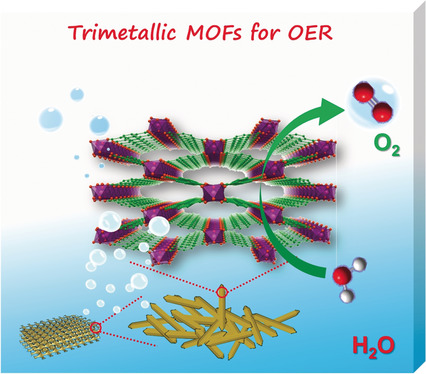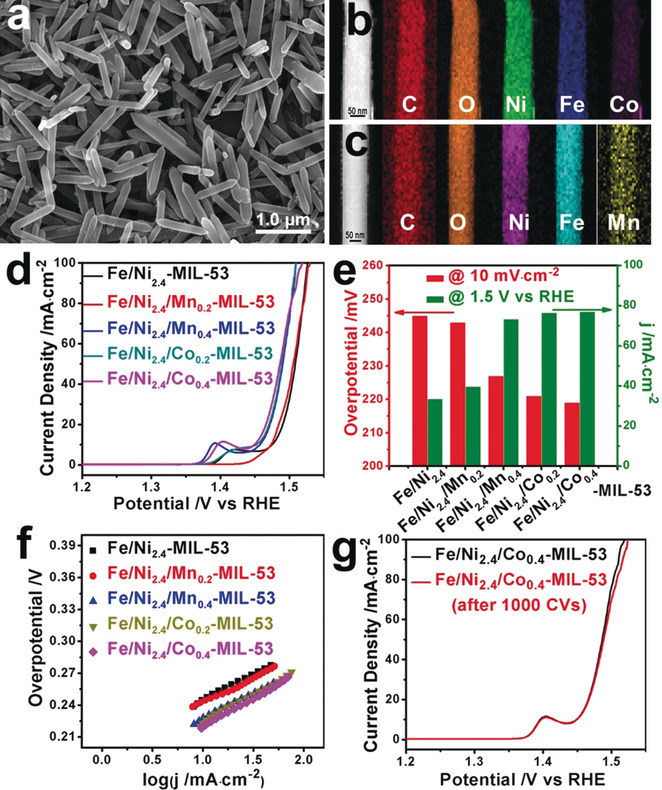Home >
News > Nanoscale Trimetallic Metal–Organic Frameworks Enable Efficient Oxygen Evolution Electrocatalysis
Nanoscale Trimetallic Metal–Organic Frameworks Enable Efficient Oxygen Evolution Electrocatalysis
Summary:
The authors from College of Chemistry Chemical Engineering and Materials Science, Soochow University and Institution State Key Laboratory of Organometallic Chemistry, Shanghai Institute of Organic Chemistry, Chinese Academy of Sciences developed nanoscale Fe/Ni-based trimetallic metal-organic frameworks (Fe/Ni/Co(Mn)-MIL-53) with characteristics like rod-shaped structure, uniform element distribution, and high porosity, achieving excellent performance in oxygen evolution reaction (OER) electrocatalysis.

Background:
1. With the energy crisis and environmental issues, efficient energy conversion systems are urgent, but the oxygen evolution reaction (OER) with sluggish kinetics limits efficiency. Precious metal-based catalysts are costly and scarce, and existing MOFs are usually used as templates after annealing, which may destroy structures and reduce active sites.
2. The authors prepared Fe/Ni-based trimetallic MOFs via solvothermal synthesis, which can be directly used as efficient OER electrocatalysts, with enhanced performance when grown on nickel foam (NF).
Research Content:
1. Synthesis:
The authors synthesized the materials using solvothermal methods. For Fe/Ni-MIL-53, Ni(NO₃)₂·6H₂O, FeCl₃·6H₂O, and 1,4-BDC were reacted in DMA at 150°C for 3 h. Trimetallic Fe/Ni/Co(Mn)-MIL-53 was prepared by adding Co(NO₃)₂·6H₂O or Mn(NO₃)₂·4H₂O. NF-supported MOFs were synthesized by immersing pre-treated NF in the reaction solution.
2. Characterizations:
1) BET and pore size distribution: Fe/Ni₂.₄-MIL-53 and Fe/Ni₂.₄/Co₀.₄-MIL-53 have specific surface areas and pore structures (Figure S13).
2) SEM/TEM tests: Fe/Ni₂.₄-MIL-53 are uniform rod-like nanocrystals with average length ~900 nm and diameter ~100 nm; trimetallic MOFs show similar rod shapes (Figures 1a, b, 3a, S1, S9).
3) Other tests: XRD confirmed crystal structure matching simulated MIL-53(Fe); XPS and EDS showed uniform distribution of Fe, Ni, Co(Mn), C, and O; FT-IR spectra matched MIL-53 characteristics (Figures 1c, d, S5, S6, S8, S10, S11, S12).
3. Application:
The materials were tested for OER. Fe/Ni₂.₄/Co₀.₄-MIL-53 reached 20 mA cm⁻² at 236 mV overpotential with a Tafel slope of 52.2 mV dec⁻¹. NF-supported Fe/Ni/Mn₀.₄-MIL-53 achieved 100 and 500 mA cm⁻² at 238 and 290 mV, with good stability over 60 h (Figures 2, 3, 5).
4. Mechanism:
The enhanced OER performance is attributed to the synergy of mixed metals (Ni as active sites, Fe, Co/Mn modulating electronic properties), unique porous structure, and uniform element distribution. XPS showed Ni 2p peaks shifted to higher binding energy in trimetallic MOFs, optimizing active sites (Figure 4).

Outlook:
This research demonstrates that trimetallic MOFs can be directly used as efficient OER electrocatalysts, avoiding structural destruction from annealing. It provides a new strategy for designing MOFs with high activity and stability for energy conversion.
Nanoscale Trimetallic Metal–Organic Frameworks Enable Efficient Oxygen Evolution Electrocatalysis
Authors: Fei-Long Li, Qi Shao, Xiaoqing Huang, Jian-Ping Lang
DOI: 10.1002/anie.201711376
Link: https://onlinelibrary.wiley.com/doi/abs/10.1002/anie.201711376
The above review is for academic progress sharing. For any errors or copyright issues, please contact us for correction or removal.

